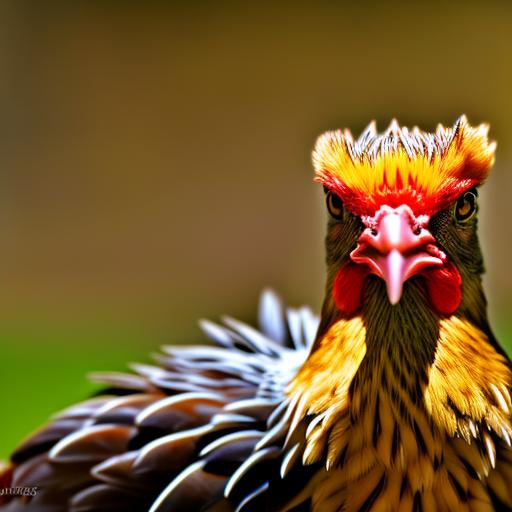Chicken housing is an essential aspect of raising chickens, whether it be for personal use or commercial purposes. Providing a suitable shelter for chickens is crucial for their well-being and productivity. Understanding the basics of chicken housing is important in order to make informed decisions about the type of housing that best suits your needs and values.
Key Takeaways
- Chicken housing is important for the health and safety of your birds
- Keeping chickens in a cage has both advantages and disadvantages
- Choosing the right type of cage is crucial for the well-being of your chickens
- Proper setup and maintenance of the cage is necessary for a healthy environment
- Ethical concerns should be considered when deciding on chicken housing options
Understanding the basics of chicken housing
A. The importance of shelter for chickens
Shelter is vital for chickens as it provides protection from predators, extreme weather conditions, and diseases. A well-designed chicken house can also help to maintain a clean and healthy environment for the birds, which in turn promotes their overall health and productivity. Additionally, a proper shelter can provide a sense of security and comfort for the chickens, allowing them to exhibit natural behaviors and reduce stress.
B. Factors to consider when choosing a chicken housing option
When choosing a chicken housing option, there are several factors to consider. These include the number of chickens you plan to keep, the available space on your property, the climate in your area, and your budget. It is important to choose a housing option that provides adequate space for the chickens to move around, roost, and lay eggs comfortably. The housing should also be well-ventilated and provide protection from predators and extreme weather conditions.
The pros and cons of keeping chickens in a cage
A. Advantages of keeping chickens in a cage
Keeping chickens in a cage has its advantages. Cages provide a controlled environment where the chickens are protected from predators and have limited exposure to diseases. Cages also make it easier to monitor the health and behavior of individual birds, as well as collect eggs. Additionally, cages can be more space-efficient compared to other housing options, allowing for higher stocking densities.
B. Disadvantages of keeping chickens in a cage
However, there are also disadvantages to keeping chickens in a cage. Caged chickens have limited space to move around and exhibit natural behaviors, which can lead to stress and health issues. They may also be more prone to developing behavioral problems such as feather pecking and cannibalism. Furthermore, caged systems require regular cleaning and maintenance to prevent the buildup of waste and ensure a clean and healthy environment for the chickens.
Choosing the right type of cage for your chickens
A. Different types of chicken cages
There are various types of chicken cages available on the market, each with its own advantages and disadvantages. Battery cages are the most common type of cage used in commercial egg production. These cages are typically small and stacked in multiple tiers, allowing for high stocking densities. Another type of cage is the enriched colony system, which provides more space and amenities for the chickens compared to battery cages. Free-range systems allow chickens to roam freely outdoors during the day while providing shelter at night.
B. Factors to consider when choosing a chicken cage
When choosing a chicken cage, it is important to consider factors such as the number of chickens you plan to keep, the available space, and your budget. Battery cages may be suitable for commercial operations with large numbers of chickens, but they may not be ideal for smaller-scale or backyard operations where space is limited. Enriched colony systems or free-range systems may be more suitable for those who prioritize animal welfare and want to provide a more natural environment for their chickens.
How to properly set up a chicken cage
A. Preparing the location for the chicken cage
Before setting up a chicken cage, it is important to prepare the location properly. Choose a level area that is well-drained and away from areas prone to flooding or excessive moisture. Clear any debris or vegetation from the area and ensure that there is adequate space for the size of the cage you plan to install.
B. Assembling the chicken cage
Once the location is prepared, follow the manufacturer’s instructions to assemble the chicken cage. Make sure all components are securely fastened and that the cage is stable. Install any necessary accessories such as perches, nesting boxes, and feeders. Ensure that the cage is properly ventilated and provides adequate lighting for the chickens.
Maintaining a clean and healthy chicken cage environment

A. Importance of cleanliness in a chicken cage
Maintaining a clean and healthy environment in the chicken cage is crucial for the well-being of the birds. A dirty and unsanitary environment can lead to the spread of diseases, parasites, and pests. It can also contribute to poor air quality and increase the risk of respiratory issues for the chickens.
B. Tips for maintaining a clean and healthy chicken cage environment
To maintain a clean and healthy chicken cage environment, it is important to regularly clean and disinfect the cage. Remove any accumulated waste, such as droppings and feathers, on a daily basis. Replace bedding material regularly to prevent the buildup of moisture and odors. Provide adequate ventilation to ensure good air circulation and reduce humidity levels. Regularly inspect the cage for any signs of damage or wear and repair or replace as necessary.
Providing adequate food and water for caged chickens
A. Importance of proper nutrition for chickens
Providing adequate nutrition is essential for the health and productivity of caged chickens. A balanced diet that meets their nutritional requirements will ensure optimal growth, egg production, and overall well-being. Proper nutrition also helps to strengthen their immune system, making them more resistant to diseases.
B. Tips for providing adequate food and water for caged chickens
To provide adequate food and water for caged chickens, it is important to offer a balanced diet that includes a combination of grains, protein sources, vitamins, and minerals. Ensure that feeders are easily accessible to all chickens and are kept clean to prevent contamination. Provide fresh water at all times and regularly clean and refill water containers to prevent the growth of bacteria.
Ensuring proper ventilation and lighting for caged chickens
A. Importance of proper ventilation and lighting in a chicken cage
Proper ventilation and lighting are crucial for the health and well-being of caged chickens. Good ventilation helps to remove excess heat, moisture, and odors from the cage, ensuring a comfortable environment for the birds. Adequate lighting is important for maintaining a natural day-night cycle, promoting healthy growth, and stimulating egg production.
B. Tips for ensuring proper ventilation and lighting for caged chickens
To ensure proper ventilation in a chicken cage, provide adequate openings or vents that allow for the exchange of fresh air. Avoid overcrowding the cage, as this can hinder air circulation. Monitor temperature and humidity levels regularly and make adjustments as necessary. For lighting, provide a combination of natural light and artificial light to ensure a consistent day-night cycle. Use light bulbs specifically designed for poultry to provide the appropriate spectrum of light.
Addressing ethical concerns surrounding caged chickens
A. Common ethical concerns surrounding caged chickens
Caged chicken farming has been the subject of ethical concerns due to the limited space and restrictions on natural behaviors that it imposes on the birds. Many people argue that keeping chickens in cages is inhumane and goes against their natural instincts to roam, perch, dust bathe, and socialize.
B. Ways to address ethical concerns surrounding caged chickens
To address ethical concerns surrounding caged chickens, alternative housing systems such as enriched colony systems or free-range systems can be considered. These systems provide more space and amenities for the chickens, allowing them to exhibit more natural behaviors. Additionally, implementing animal welfare standards and regulations can help ensure that caged chickens are provided with adequate care and living conditions.
The impact of cage-free and free-range chicken farming
A. Advantages of cage-free and free-range chicken farming
Cage-free and free-range chicken farming have gained popularity in recent years due to the perceived benefits for animal welfare. These systems allow chickens to roam freely, exhibit natural behaviors, and have more space compared to caged systems. They also provide opportunities for chickens to access outdoor areas, which can contribute to their overall well-being.
B. Disadvantages of cage-free and free-range chicken farming
However, there are also disadvantages to cage-free and free-range chicken farming. These systems require more space and resources compared to caged systems, which can make them less economically viable for some producers. They also present challenges in terms of predator control, disease management, and egg collection. Additionally, there is a risk of chickens being exposed to environmental hazards or contracting diseases from wild birds or other animals.
Making an informed decision about chicken housing based on your needs and values
A. Factors to consider when making a decision about chicken housing
When making a decision about chicken housing, it is important to consider factors such as your specific needs, available resources, and personal values. Consider the number of chickens you plan to keep, the available space on your property, the climate in your area, and your budget. Also, think about your priorities in terms of animal welfare, sustainability, and the overall impact of your choices.
B. Importance of aligning your decision with your needs and values
Aligning your decision about chicken housing with your needs and values is important as it ensures that you are providing the best possible care for your chickens while also staying true to your beliefs. By considering all relevant factors and weighing the pros and cons of different housing options, you can make an informed decision that meets both your practical requirements and ethical considerations.
Understanding the basics of chicken housing is crucial for anyone involved in raising chickens. Providing a suitable shelter for chickens is essential for their well-being, productivity, and overall health. By considering factors such as the type of housing, cleanliness, nutrition, ventilation, and lighting, you can create a comfortable and healthy environment for your chickens. It is also important to address ethical concerns surrounding caged chickens and consider alternative housing systems that align with your values. Ultimately, making an informed decision about chicken housing based on your needs and values will ensure the best possible care for your chickens.
If you’re wondering about the best way to keep chickens, you may be interested in an article on Poultry Wizard titled “Rent a Chicken Coop: A Convenient Solution for Urban Chicken Keepers.” This article explores the benefits of renting a chicken coop, providing a practical and hassle-free option for those who want to keep chickens but may not have the space or resources to build their own coop. It’s a great read for anyone looking to embark on their chicken-keeping journey. Check it out here.
FAQs
Can you keep chickens in a cage?
Yes, you can keep chickens in a cage, but it is not recommended for their overall health and well-being.
What are the disadvantages of keeping chickens in a cage?
Keeping chickens in a cage can lead to health problems such as obesity, feather loss, and stress. It can also limit their ability to move around and exhibit natural behaviors such as dust bathing and foraging.
What is the recommended space requirement for chickens?
The recommended space requirement for chickens is at least 4 square feet per bird in the coop and 10 square feet per bird in the outdoor run.
What should be included in a chicken’s living space?
A chicken’s living space should include a coop for sleeping and laying eggs, an outdoor run for exercise and foraging, and access to food and water.
What are some alternatives to keeping chickens in a cage?
Some alternatives to keeping chickens in a cage include free-range, pastured, or backyard chicken keeping. These methods allow chickens to move around freely and exhibit natural behaviors.
Meet Walter, the feathered-friend fanatic of Florida! Nestled in the sunshine state, Walter struts through life with his feathered companions, clucking his way to happiness. With a coop that’s fancier than a five-star hotel, he’s the Don Juan of the chicken world. When he’s not teaching his hens to do the cha-cha, you’ll find him in a heated debate with his prized rooster, Sir Clucks-a-Lot. Walter’s poultry passion is no yolk; he’s the sunny-side-up guy you never knew you needed in your flock of friends!







